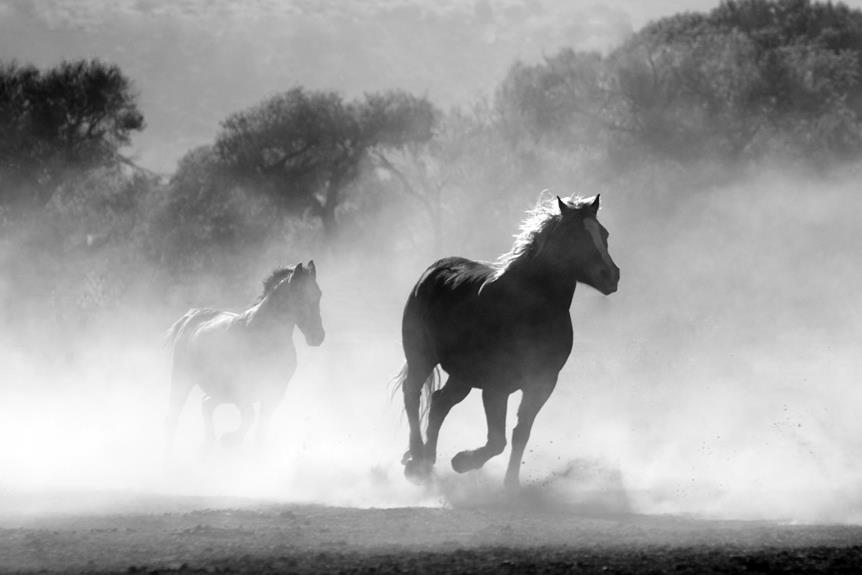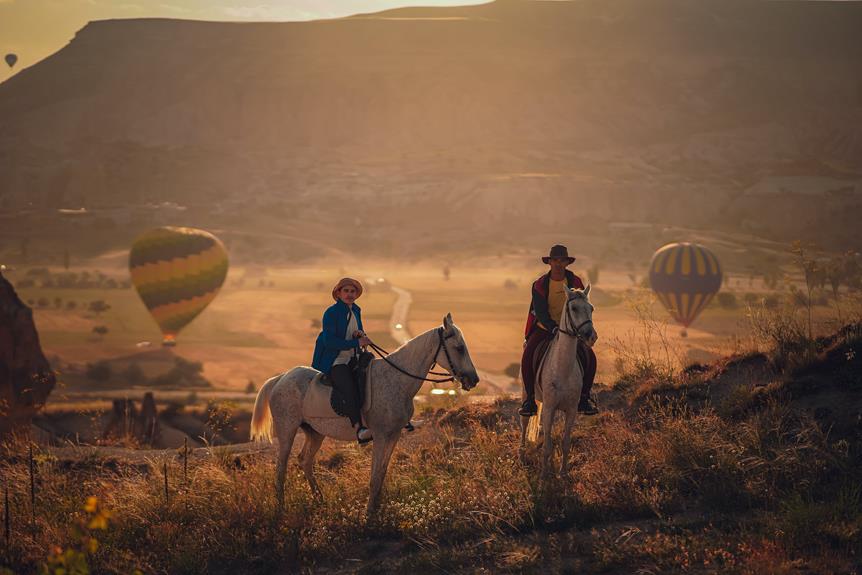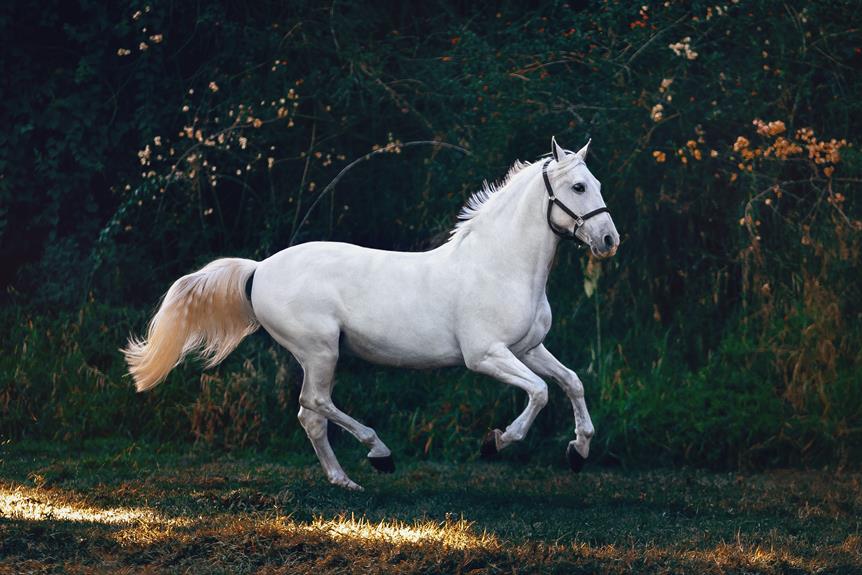As you saddle up and prepare to embark on your equine journey, have you ever wondered about the inner workings of a horse's digestive system? Well, hold onto your reins because we're about to uncover a fascinating fact: despite what some may believe, a horse does not possess multiple stomachs like a ravenous beast from medieval folklore.
However, this doesn't mean that their stomach is any less intriguing. In fact, the horse's stomach is a vital component of its digestive process, playing a crucial role in maintaining its overall health.
So, let's delve into the depths of equine anatomy and explore the intricacies of the horse's singular, yet powerful, stomach.
Key Takeaways
- The horse's stomach consists of two sections: the glandular and non-glandular regions.
- The non-glandular region is more prone to ulcers.
- The stomach plays a vital role in the overall digestion process of horses.
- Factors such as stress and high-grain diets can increase the risk of gastric ulcers in horses.
The Anatomy of a Horse's Stomach
The anatomy of a horse's stomach consists of two sections. One section contains glands that secrete digestive fluids, while the other section lacks glands and is prone to gastric ulcers. Understanding the structure of a horse's stomach is crucial for maintaining its digestive health.
After the food is ingested, it passes through the esophagus and enters the stomach. The stomach of a horse is a relatively simple organ, similar to that of humans. It has a capacity of approximately 2-4 gallons. The digestive process begins in the stomach, where the food is mixed with digestive fluids secreted by the glandular section.
Once the food leaves the stomach, it enters the small intestine. The small intestine is responsible for the rapid passage, digestion, and absorption of non-structural carbohydrates, proteins, and fats. It's approximately 70 feet long and plays a vital role in the horse's digestion.
After the small intestine, the food enters the large intestine. The large intestine is composed of the cecum, large colon, small colon, and rectum. In this section, microbial digestion of dietary fiber occurs, and volatile fatty acids are produced. The large intestine is a crucial part of the horse's digestive tract.
Proper chewing, saliva production, and balanced forage intake are essential for maintaining optimal digestive health in horses. Feeding small, frequent meals and providing a diet rich in fiber can help support the horse's digestive system and prevent issues such as ulcers and colic. Understanding the anatomy of a horse's stomach is vital for ensuring its overall well-being.
The Digestive Process in Horses
To understand how a horse's digestive system operates, let's explore the intricate process of digestion in these magnificent animals.
The equine digestive tract consists of the foregut and hindgut. The foregut includes the stomach and the small intestine, while the hindgut comprises the cecum, large colon, small colon, rectum, and anus.
The digestive process begins in the mouth, where horses produce saliva to moisten their food and aid in its passage through the digestive tract. From there, the food travels down the esophagus and enters the stomach, which is a simple, glandular organ. In the stomach, the food is mixed with gastric juices, breaking it down further before it moves into the small intestine.
The small intestine is responsible for digesting and absorbing non-structural carbohydrates, proteins, and fats. It's composed of three sections: the duodenum, jejunum, and ileum. Once the food is sufficiently broken down and absorbed in the small intestine, it passes into the large intestine.
In the large intestine, microbial fermentation takes place, primarily in the cecum. This fermentation process helps break down structural carbohydrates and produces volatile fatty acids, which are a source of energy for the horse. The large intestine consists of the cecum, large colon, and small colon. Finally, the undigested materials move into the rectum and are expelled through the anus.
Understanding the digestive process in horses is crucial for maintaining their health. Feeding small meals frequently and providing a balanced diet can promote optimal digestion. Additionally, minimizing stress and ensuring access to fresh water at all times contribute to a healthy equine digestive system.
Understanding the Equine Foregut
Explore the intricate workings of a horse's foregut, where physical and chemical digestion occur before microbial fermentation takes place. Understanding the equine foregut is essential for comprehending the digestive process in horses. Here are three key points to consider:
- The Equine Foregut: The foregut of a horse includes the mouth, esophagus, stomach, and small intestine. These structures play a vital role in the initial stages of digestion before food reaches the hindgut, which consists of the large intestine.
- Physical and Chemical Digestion: In the foregut, physical digestion begins as the horse chews its food, breaking it down into smaller particles. The stomach then secretes acid and enzymes to further break down the food. This process, known as chemical digestion, prepares the ingested material for absorption in the small intestine.
- Saliva Production and Diet: Horses produce a significant amount of saliva, ranging from 20 to 80 liters per day. This saliva contains bicarbonate, which helps neutralize the stomach acid. Additionally, saliva contains amylase, an enzyme that initiates the breakdown of carbohydrates. Horses are designed to graze on small frequent meals, as their equine gastrointestinal tract continually secretes digestive enzymes and gastric acid. This helps maintain a steady rate of passage through the digestive system and optimal digestion.
Understanding the equine foregut is crucial for providing horses with a proper diet and ensuring their overall health and well-being. By comprehending the physical and chemical processes that occur in this part of the digestive system, horse owners and caretakers can make informed decisions regarding feeding practices and management strategies.
Exploring the Equine Hindgut
Now that you have a solid understanding of the equine foregut and its role in the initial stages of digestion, let's delve into the fascinating world of the equine hindgut.
The hindgut is a crucial part of the horse's digestive system, consisting of the large intestine, small intestine, rectum, and anus. Unlike the foregut, which primarily focuses on enzymatic digestion and absorption, the hindgut specializes in microbial digestion.
One important component of the hindgut is the caecum, a blind sack that can hold around 28-36 liters of feed and fluid. It acts as a microbial inoculation vat, similar to the rumen in a cow. The caecum plays a vital role in the horse's digestion by allowing billions of symbiotic bacteria to break down plant fibers and undigested starches into volatile fatty acids (VFAs).
The large colon and small colon are also part of the hindgut. They further aid in the microbial fermentation process and absorb water and electrolytes from the digesta. Together, these structures ensure that the horse maximizes nutrient extraction from its diet.
It is important to note that the stomach of the horse isn't part of the hindgut. The stomach lining is susceptible to issues such as gastric ulcers, which can affect digestion and overall health. Understanding the hindgut's role in microbial digestion can help horse owners and caretakers make informed decisions regarding diet and management practices to promote a healthy digestive system.
The Role of the Horse's Stomach in Digestive Health
Understanding the importance of the horse's stomach in maintaining digestive health is crucial for horse owners and caretakers.
The horse's stomach, although relatively small compared to the rest of the digestive system, plays a vital role in the overall digestion process.
Here are three key points to consider:
- Digestive Function: The horse's stomach, comprising only 10% of the digestive system, is responsible for the initial stage of digestion. When the horse consumes food, it enters the stomach where it's mixed with pepsin and hydrochloric acid. This mixture breaks down the food into smaller particles, preparing it for further digestion in the small intestine.
- Acid Production: Horses produce a significant amount of stomach acid, up to 1.5 liters per hour, even when the stomach is empty. This continuous production of acid is necessary for optimal digestion. However, it also puts horses at risk of developing gastric ulcers if the acid comes into contact with the non-glandular region of the stomach.
- Importance of Saliva: Saliva plays a crucial role in buffering the stomach acid and reducing the risk of ulcers. Horses produce around 10-12 liters of saliva per day, which helps neutralize the acid in the stomach. Chewing hay and dry forage stimulates saliva production, making it essential to include roughage in the horse's diet.
Frequently Asked Questions
Do Horses Have Two Stomachs?
No, horses don't have two stomachs. They have one stomach, like humans. But their digestive system is unique, with a foregut and hindgut. Fermentation plays a role in their digestion, and their multiple stomachs affect their diet and overall health.
How Many Stomachs Do Deer Have?
Deer have a four-chambered stomach, just like cows. Their stomachs, called the rumen, reticulum, omasum, and abomasum, help them digest plants. The fermentation process in their gut allows them to extract nutrients from their diet.
How Many Stomachs Do Goats Have?
Goats, like horses, have one stomach. However, unlike horses, goats have a unique digestive system that includes a rumen and multiple stomach compartments. This allows them to ferment food, chew cud, and efficiently digest their diet.
How Long Does It Take a Horse to Poop After Eating?
After eating, a horse's digestive process begins. It breaks down food, absorbs nutrients, and eliminates waste through bowel movements. Factors like food type, activity level, and gut health affect the speed of digestion and poop consistency.
Conclusion
So, as you can see, a horse only has one stomach.
However, the horse's digestive system is complex, with different regions responsible for different aspects of digestion.
The stomach plays a crucial role in chemical digestion, while the small intestine is where most of the breakdown of nutrients occurs.
The hindgut, on the other hand, is responsible for microbial digestion.
Understanding the anatomy and functions of a horse's digestive system is essential for maintaining their digestive health.



0 Comments